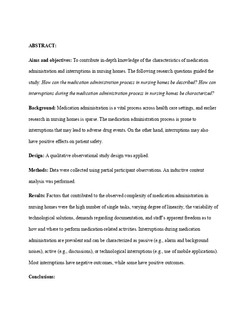| dc.contributor.author | Odberg, Kristian Ringsby | |
| dc.contributor.author | Hansen, Britt Sætre | |
| dc.contributor.author | Aase, Karina | |
| dc.contributor.author | Wangensteen, Sigrid | |
| dc.date.accessioned | 2019-06-24T11:28:26Z | |
| dc.date.available | 2019-06-24T11:28:26Z | |
| dc.date.created | 2017-10-25T08:42:07Z | |
| dc.date.issued | 2018 | |
| dc.identifier.citation | Journal of Clinical Nursing. 2018, 27 (5-6), 1113-1124. | nb_NO |
| dc.identifier.issn | 0962-1067 | |
| dc.identifier.uri | http://hdl.handle.net/11250/2601854 | |
| dc.description.abstract | Aims and objectives
To contribute in‐depth knowledge of the characteristics of medication administration and interruptions in nursing homes. The following research questions guided the study: How can the medication administration process in nursing homes be described? How can interruptions during the medication administration process in nursing homes be characterized?
Background
Medication administration is a vital process across healthcare settings, and earlier research in nursing homes is sparse. The medication administration process is prone to interruptions that may lead to adverse drug events. On the other hand, interruptions may also have positive effects on patient safety.
Design
A qualitative observational study design was applied.
Methods
Data were collected using partial participant observations. An inductive content analysis was performed.
Results
Factors that contributed to the observed complexity of medication administration in nursing homes were the high number of single tasks, varying degree of linearity, the variability of technological solutions, demands regarding documentation and staff's apparent freedom as to how and where to perform medication‐related activities. Interruptions during medication administration are prevalent and can be characterised as passive (e.g., alarm and background noises), active (e.g., discussions) or technological interruptions (e.g., use of mobile applications). Most interruptions have negative outcomes, while some have positive outcomes.
Conclusions
A process of normalisation has taken place whereby staff put up with second‐rate technological solutions, noise and interruptions when they are performing medication‐related tasks. Before seeking to minimise interruptions during the medication administration process, it is important to understand the interconnectivity of the elements using a systems approach.
Relevance to clinical practice
Staff and management need to be aware of the normalisation of interruptions. Knowledge of the complexity of medication administration may raise awareness and highlight the importance of maintaining and enhancing staff competence. | nb_NO |
| dc.language.iso | eng | nb_NO |
| dc.publisher | Wiley | nb_NO |
| dc.title | Medication administration and interruptions in nursing homes: A qualitative observational study | nb_NO |
| dc.type | Journal article | nb_NO |
| dc.type | Peer reviewed | nb_NO |
| dc.description.version | acceptedVersion | nb_NO |
| dc.source.pagenumber | 1113-1124 | nb_NO |
| dc.source.volume | 27 | nb_NO |
| dc.source.journal | Journal of Clinical Nursing | nb_NO |
| dc.source.issue | 5-6 | nb_NO |
| dc.identifier.doi | 10.1111/jocn.14138 | |
| dc.identifier.cristin | 1507454 | |
| dc.relation.project | SHARE - Centre for Resilience in Healthcare: 7291 | nb_NO |
| dc.description.localcode | Locked until 27.10.2019 due to copyright restrictions. This is the peer reviewed version of an article, which has been published in final form at [https://doi.org/10.1111/jocn.14138]. This article may be used for non-commercial purposes in accordance with Wiley Terms and Conditions for Self-Archiving. | nb_NO |
| cristin.unitcode | 194,65,70,0 | |
| cristin.unitname | Institutt for helsevitenskap Gjøvik | |
| cristin.ispublished | true | |
| cristin.fulltext | original | |
| cristin.qualitycode | 2 | |
